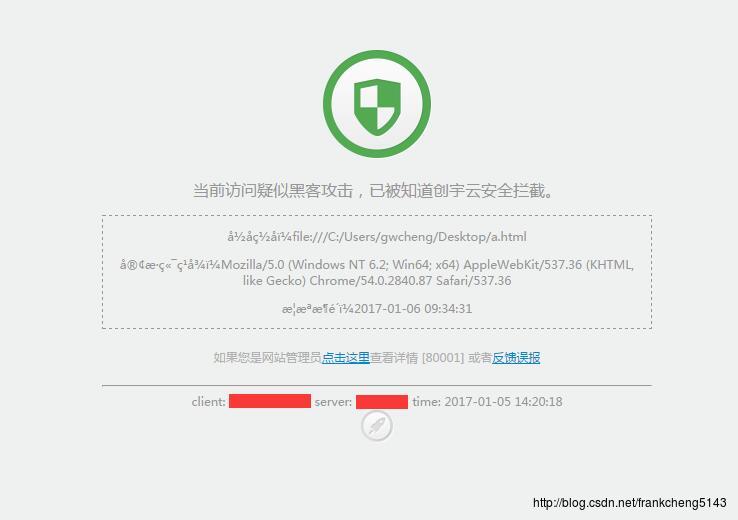使用User-Agent防止HttpClient发送http请求时403 Forbidden和安全拦截
Posted GW_Cheng
tags:
篇首语:本文由小常识网(cha138.com)小编为大家整理,主要介绍了使用User-Agent防止HttpClient发送http请求时403 Forbidden和安全拦截相关的知识,希望对你有一定的参考价值。
之前写过一个Java工具类–通过HttpClient发送http请求
最近在访问一个接口的时候被拒绝了。具体信息如下

我们用程序访问我的csdn博客地址

解决方案就是在httpclient发出请求的时候在Header中设置一个User-Agent
具体如下
String userAgent = "Mozilla/5.0 (Windows NT 6.2; Win64; x64) AppleWebKit/537.36 (Khtml, like Gecko) Chrome/54.0.2840.87 Safari/537.36";
HttpGet httpGet = new HttpGet(url);
httpGet.setHeader("User-Agent",userAgent);
response = httpclient.execute(httpGet);我电脑的谷歌浏览器User-Agent

加上User-Agent之后访问我的博客地址

完整的代码
HttpUtil.java
package com.jrbac.util;
import java.io.File;
import java.io.IOException;
import java.util.ArrayList;
import java.util.List;
import java.util.Map;
import org.apache.http.Consts;
import org.apache.http.HttpEntity;
import org.apache.http.NameValuePair;
import org.apache.http.client.ClientProtocolException;
import org.apache.http.client.entity.UrlEncodedFormEntity;
import org.apache.http.client.methods.CloseableHttpResponse;
import org.apache.http.client.methods.HttpGet;
import org.apache.http.client.methods.HttpPost;
import org.apache.http.entity.StringEntity;
import org.apache.http.entity.mime.HttpMultipartMode;
import org.apache.http.entity.mime.MultipartEntityBuilder;
import org.apache.http.entity.mime.content.FileBody;
import org.apache.http.impl.client.CloseableHttpClient;
import org.apache.http.impl.client.HttpClients;
import org.apache.http.message.BasicNameValuePair;
import org.apache.http.util.EntityUtils;
import org.slf4j.Logger;
import org.slf4j.LoggerFactory;
/**
* Http工具类,发送Http请求, Get请求请将参数放在url中 Post请求请将参数放在Map中
*
* @author 程高伟
* @date 2017年1月5日 下午6:03:50
*/
public class HttpUtil
private static final Logger log = LoggerFactory.getLogger(HttpUtil.class);
private static final CloseableHttpClient httpclient = HttpClients.createDefault();
private static final String userAgent = "Mozilla/5.0 (Windows NT 6.2; Win64; x64) AppleWebKit/537.36 (KHTML, like Gecko) Chrome/54.0.2840.87 Safari/537.36";
/**
* 发送HttpGet请求
*
* @param url
* 请求地址
* @return 返回字符串
*/
public static String sendGet(String url)
String result = null;
CloseableHttpResponse response = null;
try
HttpGet httpGet = new HttpGet(url);
httpGet.setHeader("User-Agent", userAgent);
response = httpclient.execute(httpGet);
HttpEntity entity = response.getEntity();
if (entity != null)
result = EntityUtils.toString(entity);
catch (Exception e)
log.error("处理失败 " + e);
e.printStackTrace();
finally
if (response != null)
try
response.close();
catch (IOException e)
log.error(e.getMessage());
return result;
/**
* 发送HttpPost请求,参数为map
*
* @param url
* 请求地址
* @param map
* 请求参数
* @return 返回字符串
*/
public static String sendPost(String url, Map<String, String> map)
// 设置参数
List<NameValuePair> formparams = new ArrayList<NameValuePair>();
for (Map.Entry<String, String> entry : map.entrySet())
formparams.add(new BasicNameValuePair(entry.getKey(), entry.getValue()));
// 编码
UrlEncodedFormEntity formEntity = new UrlEncodedFormEntity(formparams, Consts.UTF_8);
// 取得HttpPost对象
HttpPost httpPost = new HttpPost(url);
// 防止被当成攻击添加的
httpPost.setHeader("User-Agent", userAgent);
// 参数放入Entity
httpPost.setEntity(formEntity);
CloseableHttpResponse response = null;
String result = null;
try
// 执行post请求
response = httpclient.execute(httpPost);
// 得到entity
HttpEntity entity = response.getEntity();
// 得到字符串
result = EntityUtils.toString(entity);
catch (IOException e)
log.error(e.getMessage());
finally
if (response != null)
try
response.close();
catch (IOException e)
log.error(e.getMessage());
return result;
/**
* 发送HttpPost请求,参数为文件,适用于微信上传素材
*
* @param url
* 请求地址
* @param file
* 上传的文件
* @return 返回字符串
* @throws IOException
* @throws ClientProtocolException
*/
public static String sendPost(String url, File file)
String result = null;
HttpPost httpPost = new HttpPost(url);
// 防止被当成攻击添加的
httpPost.setHeader("User-Agent", userAgent);
MultipartEntityBuilder multipartEntity = MultipartEntityBuilder.create();
multipartEntity.setMode(HttpMultipartMode.BROWSER_COMPATIBLE);
multipartEntity.addPart("media", new FileBody(file));
httpPost.setEntity(multipartEntity.build());
CloseableHttpResponse response = null;
try
response = httpclient.execute(httpPost);
HttpEntity entity = response.getEntity();
result = EntityUtils.toString(entity);
catch (IOException e)
log.error(e.getMessage());
finally
// 关闭CloseableHttpResponse
if (response != null)
try
response.close();
catch (IOException e)
log.error(e.getMessage());
return result;
/**
* 发送HttpPost请求,参数为json字符串
*
* @param url
* @param jsonStr
* @return
*/
public static String sendPost(String url, String jsonStr)
String result = null;
// 字符串编码
StringEntity entity = new StringEntity(jsonStr, Consts.UTF_8);
// 设置content-type
entity.setContentType("application/json");
HttpPost httpPost = new HttpPost(url);
// 防止被当成攻击添加的
httpPost.setHeader("User-Agent", userAgent);
httpPost.setEntity(entity);
CloseableHttpResponse response = null;
try
response = httpclient.execute(httpPost);
HttpEntity httpEntity = response.getEntity();
result = EntityUtils.toString(httpEntity);
catch (IOException e)
log.error(e.getMessage());
finally
// 关闭CloseableHttpResponse
if (response != null)
try
response.close();
catch (IOException e)
log.error(e.getMessage());
return result;
/**
* 发送不带参数的HttpPost请求
*
* @param url
* @return
*/
public static String sendPost(String url)
String result = null;
// 得到一个HttpPost对象
HttpPost httpPost = new HttpPost(url);
// 防止被当成攻击添加的
httpPost.setHeader("User-Agent", userAgent);
CloseableHttpResponse response = null;
try
// 执行HttpPost请求,并得到一个CloseableHttpResponse
response = httpclient.execute(httpPost);
// 从CloseableHttpResponse中拿到HttpEntity
HttpEntity entity = response.getEntity();
// 将HttpEntity转换为字符串
result = EntityUtils.toString(entity);
catch (IOException e)
log.error(e.getMessage());
finally
// 关闭CloseableHttpResponse
if (response != null)
try
response.close();
catch (IOException e)
log.error(e.getMessage());
return result;
参考文献
以上是关于使用User-Agent防止HttpClient发送http请求时403 Forbidden和安全拦截的主要内容,如果未能解决你的问题,请参考以下文章